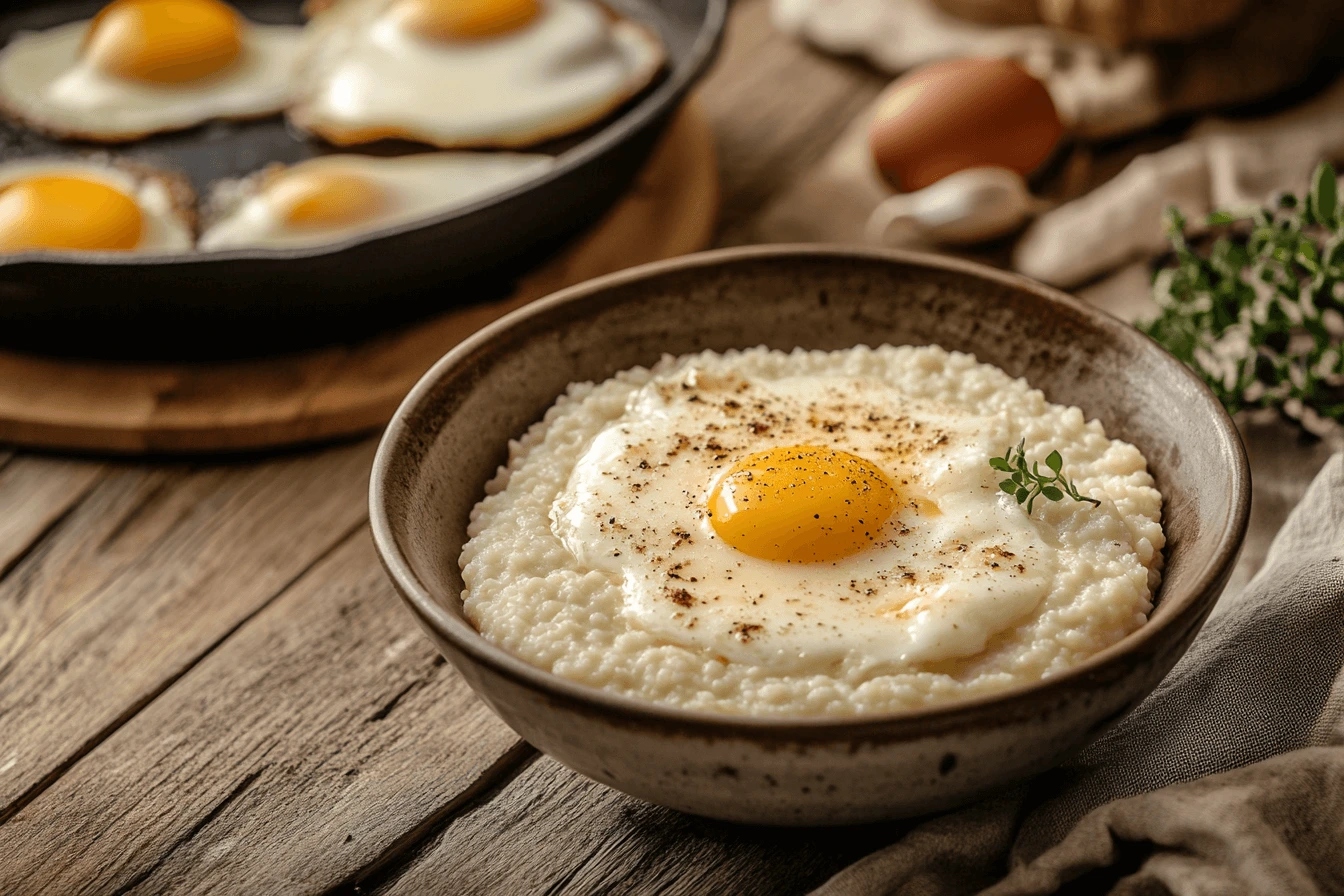When it comes to Southern comfort food, few dishes are as beloved and iconic as eggs and grits. This simple yet satisfying meal has been a staple in Southern households for generations, offering a perfect balance of hearty grains and protein-rich eggs. Whether served plain, with a dash of butter and salt, or enhanced with cheese, bacon, or even shrimp, eggs and grits have found a place on breakfast tables across the United States.
This dish is more than just a meal—it’s a symbol of Southern hospitality and tradition. Many families have passed down their unique methods of preparing eggs and grits, adding personal touches that reflect regional flavors and preferences. While the dish is most commonly enjoyed at breakfast, it can also be a comforting lunch or dinner option, proving its versatility in the kitchen.
But eggs and grits aren’t just about flavor and tradition; they’re also nutritionally beneficial. Grits provide a good source of fiber and essential minerals, while eggs deliver high-quality protein, healthy fats, and essential vitamins. Together, they make for a meal that’s both delicious and nourishing.
In this article, we’ll take a deep dive into the history, nutritional value, cooking techniques, and popular variations of eggs and grits. Whether you’re a longtime lover of this dish or a newcomer eager to try it, this guide will provide everything you need to know to prepare and enjoy the perfect plate of eggs and grits.
The History and Origins of Eggs and Grits
The Origins of Grits in Native American Cuisine
Grits have a long and rich history that dates back centuries, originating from Native American communities that cultivated and processed corn as a staple food. Native Americans introduced early European settlers to a dish made from ground maize, which was boiled into a porridge-like consistency. This dish eventually evolved into what we now know as grits. The word “grits” comes from the Old English term “grytt,” meaning coarse meal or ground grain.
Southern states, especially those with large corn-growing regions, quickly adopted grits into their daily cuisine. Over time, grits became synonymous with Southern comfort food, often served alongside meats, seafood, and eggs.
As grits became a common dish in the South, people began pairing them with eggs for a complete, protein-packed meal. Farmers and laborers relied on this hearty combination to provide sustained energy throughout the day. The simplicity, affordability, and nutritional value of eggs and grits made it a breakfast staple in many Southern households.
By the 19th and 20th centuries, eggs and grits had become a symbol of Southern hospitality and home cooking. Today, the dish is still deeply rooted in Southern culinary traditions, enjoyed in both home kitchens and restaurants across the country.
Nutritional Benefits of Eggs and Grits
Health Benefits of Eggs
Eggs are often referred to as a “nutritional powerhouse” because they provide essential vitamins, minerals, and protein in a small package. Here are some of the key nutritional benefits of eggs:
- High-Quality Protein – One large egg contains about 6 grams of protein, which helps with muscle building and repair.
- Rich in Vitamins – Eggs contain vitamin A, B12, D, and choline, which support brain function, immune health, and vision.
- Healthy Fats – Eggs provide a good balance of unsaturated fats and essential fatty acids that promote heart health.
- Low in Calories – A single egg contains only about 70 calories, making it an excellent addition to a balanced diet.
The Nutritional Value of Grits
Grits, made from ground corn, provide a good source of carbohydrates and fiber, making them a perfect complement to eggs. Some of the key health benefits of grits include:
- Energy Boosting – Grits are rich in complex carbohydrates, providing long-lasting energy.
- Good Source of Iron – Many grits are fortified with iron, which is essential for red blood cell production.
- Gluten-Free – Since grits are made from corn, they are naturally gluten-free, making them a great option for those with gluten sensitivities.
- Low in Fat – Plain grits contain very little fat, making them a healthy carbohydrate option.
How Eggs and Grits Provide a Balanced Meal
When combined, eggs and grits create a balanced meal that offers a mix of protein, fiber, healthy fats, and essential nutrients. This dish helps keep you full and energized, making it a great option for breakfast, lunch, or even dinner.
How to Cook the Perfect Eggs and Grits
Choosing the Right Type of Grits
Before you start cooking, it’s important to understand the different types of grits available:
- Stone-Ground Grits – These are the most traditional form, offering a coarse texture and rich flavor. They take 30-45 minutes to cook but are the most flavorful.
- Regular Grits – More finely ground than stone-ground grits, these take about 10-15 minutes to cook.
- Quick Grits – These are pre-processed to cook faster, usually within 5 minutes. They have a smoother texture but may lack some of the depth of flavor.
- Instant Grits – These are the fastest option, taking only 1-2 minutes to prepare. However, they may be less flavorful and more processed.
Cooking the Grits to Perfection
To make perfectly creamy grits, follow these steps:
- Use the Right Ratio – A general rule is 4 parts liquid to 1 part grits. This keeps them from becoming too thick or dry.
- Choose Your Liquid – While water is commonly used, milk or broth adds extra creaminess and flavor.
- Bring to a Boil – Heat the liquid in a saucepan until it starts to boil.
- Slowly Add the Grits – Stir constantly while adding grits to prevent clumping.
- Simmer and Stir – Reduce heat to low and stir occasionally to prevent sticking.
- Season Well – Add butter, salt, and pepper for flavor. You can also mix in cheese for a richer taste.
Cooking the Eggs
Eggs can be prepared in many ways to complement grits. Some popular options include:
- Scrambled Eggs – Soft, fluffy scrambled eggs pair well with creamy grits.
- Fried Eggs – A runny yolk can mix beautifully into the grits for extra richness.
- Poached Eggs – A great choice for those looking for a softer, delicate texture.
- Soft-Boiled Eggs – Cut in half and placed over the grits, allowing the yolk to mix in for flavor.
Bringing It All Together
Once your eggs and grits are cooked to perfection, serve them hot with toppings like cheese, bacon, sausage, or vegetables. For an extra Southern touch, add a drizzle of hot sauce or a sprinkle of Cajun seasoning.
Popular Variations and Regional Twists
While eggs and grits are a staple in Southern cuisine, different regions and chefs have added their own unique twists to this classic dish. Whether you prefer a simple preparation or a more elaborate combination, there are countless ways to enjoy eggs and grits. Here are some of the most popular variations:

Classic Southern-Style Eggs and Grits
The traditional Southern-style version of eggs and grits keeps things simple. It typically includes:
- Creamy stone-ground grits cooked with butter, salt, and pepper
- Scrambled or fried eggs served on the side or mixed in
- Crispy bacon or sausage as a savory accompaniment
- A touch of hot sauce for added flavor
This is the most basic and widely loved version of eggs and grits, offering comfort and nostalgia in every bite.
Cheesy Grits with Eggs
Adding cheese to grits takes the dish to the next level. Cheesy grits create a rich, creamy texture that pairs beautifully with eggs. The most common cheeses used include:
- Sharp cheddar for a bold flavor
- Parmesan for a nutty and salty touch
- Cream cheese for extra smoothness
- Gouda or smoked cheddar for a smoky taste
To make this variation, simply stir in your preferred cheese after the grits have finished cooking. Serve with fried or poached eggs on top for a deliciously indulgent meal.
Shrimp and Grits with Eggs
One of the most famous variations is shrimp and grits, a dish that originated in the Lowcountry region of South Carolina but has since spread across the South. This version typically includes:
- Creamy grits made with butter, milk, and cheese
- Sautéed shrimp cooked with garlic, onions, and Cajun seasoning
- Crispy bacon or andouille sausage for added depth
- A poached or soft-boiled egg on top for extra richness
The combination of tender shrimp, creamy grits, and runny egg yolk makes this dish a Southern favorite.
Spicy Cajun-Style Eggs and Grits
For those who love bold flavors, Cajun-style eggs and grits is a fantastic option. This version incorporates spicy and smoky seasonings, often including:
- Cajun or Creole seasoning mixed into the grits
- Spicy andouille sausage or chorizo for extra heat
- Green onions and bell peppers sautéed for flavor
- A fried egg with a runny yolk to balance the spice
A drizzle of Louisiana hot sauce or a dash of paprika gives this variation an authentic Cajun kick.
Breakfast Bowl-Style Eggs and Grits
A modern take on eggs and grits involves serving them as a hearty breakfast bowl, layering ingredients for a satisfying meal. A breakfast bowl might include:
- A base of creamy grits
- Scrambled or poached eggs
- Crispy bacon or sausage crumbles
- Sautéed spinach or kale for added nutrition
- Avocado slices and a sprinkle of feta cheese

Best Ingredients and Seasonings for Flavorful Eggs and Grits
The key to making amazing eggs and grits lies in choosing high-quality ingredients and the right seasonings.
Choosing the Best Eggs and Grits
- Eggs – Farm-fresh, free-range eggs tend to have richer flavor and brighter yolks.
- Grits – Stone-ground grits offer the best texture and taste, while quick grits work well for busy mornings.
Essential Seasonings for Extra Flavor
Adding the right seasonings can enhance the flavor of eggs and grits without overpowering their natural taste. Some of the best choices include:
- Salt and black pepper – The foundation of good seasoning
- Garlic powder and onion powder – Adds depth to the grits
- Paprika or smoked paprika – Gives a subtle smoky flavor
- Cayenne pepper or red pepper flakes – For a spicy kick
- Herbs like thyme, parsley, or chives – Adds freshness
Toppings That Elevate the Dish
- Butter or heavy cream – For extra richness in the grits
- Grated cheese – Cheddar, Gouda, or pepper jack for added depth
- Crispy bacon or sausage – A perfect savory addition
- Hot sauce or salsa – For a zesty finish
- Green onions or fresh herbs – Adds a pop of color and freshness
Eggs and Grits as a Breakfast Staple
Why Eggs and Grits Are Perfect for Breakfast
Eggs and grits make an ideal breakfast choice for several reasons:
- Quick and easy to prepare – Even the traditional version takes less than 30 minutes to make.
- Packed with nutrients – They provide protein, fiber, and essential vitamins to start the day right.
- Customizable – You can keep them simple or load them with extra ingredients for variety.
- Filling and satisfying – The combination of protein from eggs and carbs from grits keeps you full for hours.
How Eggs and Grits Compare to Other Breakfast Options
Compared to many breakfast staples like pancakes or sugary cereals, eggs and grits provide:
- More protein than toast and butter
- Less sugar than most breakfast cereals
- More fiber than eggs alone
- A gluten-free alternative to biscuits or bagels
Making Eggs and Grits Part of a Nutritious Diet
To make eggs and grits even healthier, try these modifications:
- Use whole-grain or stone-ground grits instead of instant grits for more fiber.
- Cook with olive oil instead of butter for heart-healthy fats.
- Add vegetables like spinach, mushrooms, or tomatoes for extra vitamins.
- Use turkey bacon or plant-based sausage for a lighter meal.

Eggs and Grits: A Classic Southern Comfort Dish
Eggs and grits is a classic Southern breakfast dish that combines creamy, buttery grits with perfectly cooked eggs, offering a comforting and hearty start to the day. This versatile meal can be customized with various toppings and mix-ins to suit individual tastes.
- Total Time: 30 minutes
- Yield: 4 servings 1x
Ingredients
- 4 cups water
- 1 cup stone-ground grits
- 1 teaspoon kosher salt
- 4 tablespoons unsalted butter, divided
- 1 cup shredded sharp cheddar cheese
- 4 large eggs
- Salt and freshly ground black pepper, to taste
- Optional toppings: cooked bacon crumbles, chopped green onions, hot sauce
Instructions
Prepare the Grits: In a medium saucepan, bring 4 cups of water to a boil. Add 1 teaspoon of kosher salt. Gradually whisk in 1 cup of stone-ground grits to prevent lumps. Reduce the heat to low, cover, and simmer, stirring occasionally, until the grits are thick and creamy, about 20-25 minutes.
Enhance the Grits: Once the grits have reached a creamy consistency, stir in 2 tablespoons of unsalted butter and 1 cup of shredded sharp cheddar cheese until fully melted and incorporated. Taste and adjust seasoning with additional salt and freshly ground black pepper as needed.
Cook the Eggs: In a non-stick skillet over medium heat, melt the remaining 2 tablespoons of butter. Crack the eggs into the skillet, seasoning with salt and pepper. Cook to your preferred doneness: for sunny-side-up, cook without flipping until the whites are set; for over-easy, flip the eggs gently and cook for an additional minute.
Assemble the Dish: Spoon the cheesy grits into serving bowls, creating a slight well in the center. Place a cooked egg on top of each bowl of grits. Garnish with optional toppings such as cooked bacon crumbles, chopped green onions, or a dash of hot sauce for added flavor.
Notes
Grits Consistency: If the grits become too thick, stir in a small amount of water, milk, or cream to reach your desired consistency.
Cheese Variations: While sharp cheddar is traditional, feel free to experiment with other cheeses like gouda, parmesan, or Monterey Jack for different flavor profiles.
Additional Mix-ins: For a heartier meal, consider adding sautéed vegetables such as spinach, bell peppers, or mushrooms to the grits before serving.
- Author: Chef Emma
- Prep Time: 5 minutes
- Cook Time: 25 minutes
- Category: Breakfast
- Method: Stovetop
- Cuisine: Southern American
- Diet: Vegetarian
Nutrition
- Serving Size: 1 bowl
- Calories: 350
- Sugar: 1g
- Sodium: 600mg
- Fat: 22g
- Saturated Fat: 12g
- Unsaturated Fat: 8g
- Trans Fat: 0g
- Carbohydrates: 25g
- Fiber: 2g
- Protein: 12g
- Cholesterol: 220mg
Keywords: eggs and grits, cheesy grits, Southern breakfast, comfort food, savory grits
Conclusion
Eggs and grits are far more than just a simple Southern breakfast. With so many variations, flavors, and regional twists, they can be enjoyed in a way that fits any taste preference. From classic Southern-style grits to spicy Cajun flavors and modern breakfast bowls, this dish is endlessly adaptable.

